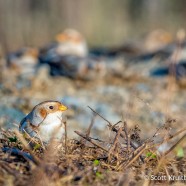Snow Buntings
It is early enough in the avian wintering season that both the earth and the birds – in this case, Snow Buntings (Plectrophenax nivalis) – are brown. We do not have a solid snow cover yet, and it is amazing how well this plumage is designed to help them blend in to the ground. The Snow Bunting camouflage looks like brown grass and, somehow, a rocky, sandy and rough earth, with their wings showing off the darker pattern of what the tundra and short grasslands look like now. Notice how well these birds keep themselves just off the surface even while engaged in feeding, hiding their...
Read MoreGood Dog
Zach here is having a good laugh at the notion that dogs like him are native parts of our ecosystem! I mentioned keeping cats indoors last week, once again describing how much damage they can do to our environment and how much pain being exposed to nature can inflict upon them. The same goes for unsupervised and untrained dogs. No one needs to see a puppy chasing a squirrel into the street and getting hit by a car. Dogs that run through the woodlands in summer can crush nests and eggs, sniff out young birds to “play” with or kill, and pick up dozens of ticks while they do,...
Read MoreCat Patrol
Why oh why is this cat outside? They kill literally billions of birds across North America each year before we even mention their damage to the small mammal population, the majority of these strikes being for play or to satisfy an instinctual need – not survival. Let us also remember the safety of these furry family members as we enter the cold weather season apart from all of the other threats such as vehicles, chemicals, larger mammalian predators, and so on. Please, please, please keep your cats in your home. They live far longer this way and your vet bills will go down as...
Read MoreNorthern Mockingbird
The Northern Mockingbird does not need a mask because its incredible vocal range can turn it into nearly anything imaginable. Depending on where you live Mimus polyglottos may be an uncommon to rare species or a typical neighborhood pest. They have been advancing north in the past several decades, possibly because of development and more favorable habitats and likely thanks to climate change. They are still a scarce bird in the Chautauqua-Allegheny region likely for both of those reasons, as well as our higher elevation. Why the pest, you ask? One day, if you’re fortunate, you may wake up to...
Read MoreAmerican Kestrel
The month of October is always a great time to find plenty of American Kestrels passing through, with this male sporting some shades of Halloween. They are often rather shy but sometimes, if you let them fly to you after chasing some prey, you will be able to get a decent look even if only for a minute. These predators will go after birds but can usually be found foraging on abundant insects like grasshoppers or even the praying mantis here in the fall.
Read More








